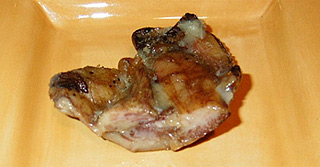Serious cooks have been bombarded over the last decade with an array of new and unique fats. Some you can fry with, while others work best as salad dressings or flavorings. Last month, I reported on the use of African palm oil (known as dende in Brazil) to finish dishes in the same way a chef might throw in a pat of butter before serving a sauce to add nuance to the flavor. Recently, many forms of Italian cured pork sporting large amounts of lard have appeared in New York markets; formerly we were lucky to find pancetta. My favorite of these new offerings is guanciale—flesh from the jaw and check of the hog, air-cured with spices that give the meat a memorable flavor something like porky pumpkin pie.

You can slice guanciale like bacon and fry it in a pan, but since the smoke point of the oils in guanciale is quite low (around 320 degrees Fahrenheit, closer to butter than bacon) the meat must be cooked slowly. The rendered lard is very tasty, though, so it’s worth the extra effort to use it as a cooking oil.
To make a dish of potatoes and guanciale, I began by cutting the cured jowl into thick slices and frying it at a low temperature in a non-stick pan, turning the heat down slightly when the first wisp of smoke appeared. When the meat was almost crisp, I removed it and put the pieces in a bowl, leaving the rendered fat in the pan. Next, I added the equivalent amount of the key ingredient: peanut oil, which smokes at 450 degrees. The smoke point of this blended oil is midway between the two oils, around 385 degrees, so I could cook at a higher temperature, and the potatoes before they fell apart.
I chose two potato varieties with different textures and water content—bintje and German butterball—just to make the dish more interesting and flavorful. I peeled and cut them into a rough three-quarter-inch dice, put them in the oil, and turned the gas flame up halfway. Then I covered the pan, turning the potatoes every few minutes to encourage even browning.
Finally, I reintroduced the guanciale rashers into the potatoes, and allowed them to reheat before removing the pan from the flame. The flavor was marvelous and exotic, completely different than if I’d made the same dish with bacon.
Pick up guanciale from your local butcher or mail order some from Buon Italia.



 Pinterest
Pinterest


